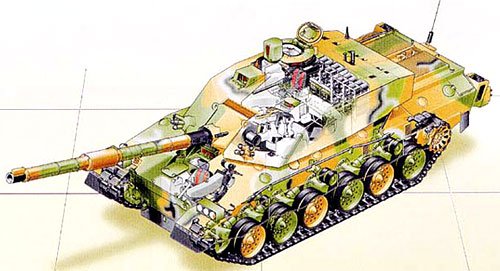Main Battle Tank Challenger 2. Tank England.
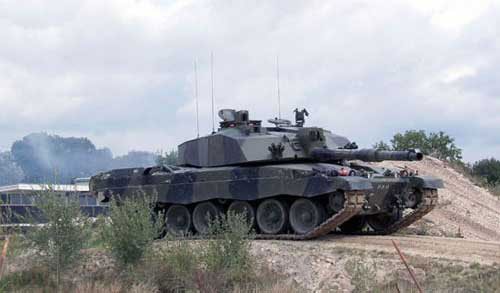 Main battle tank of the British Armed Forces until some time was the tank "Chieftain". However, in the new tank barrage of criticism, especially noted its low reliability, the inconvenience of the crew inside the tower and imperfect weapon control system. Fuel to the fire poured the failure of the British tank crews who spoke on the tanks "Challenger" in the competition for the Cup of the Canadian Army in 1987. Results of the championship of NATO tankers resulted in utter confusion the command of the British army, in fact, - the Prime Minister, Margaret Thatcher demanded that she personally reported on the causes of failure.
Main battle tank of the British Armed Forces until some time was the tank "Chieftain". However, in the new tank barrage of criticism, especially noted its low reliability, the inconvenience of the crew inside the tower and imperfect weapon control system. Fuel to the fire poured the failure of the British tank crews who spoke on the tanks "Challenger" in the competition for the Cup of the Canadian Army in 1987. Results of the championship of NATO tankers resulted in utter confusion the command of the British army, in fact, - the Prime Minister, Margaret Thatcher demanded that she personally reported on the causes of failure.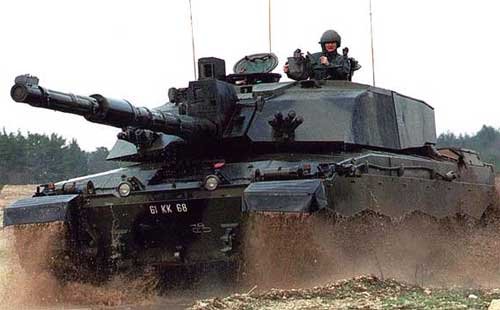 One reason for the lack of competition has been recognized among the British tank builders, and this conclusion was addressed not so much in the past as in the future. "Iron Lady" pursued a policy of rampant privatization of British industry. State tank factory in Leeds and become a monopolist in the production of main battle tanks on the island. However, the choice of the tank, designed to replace the "Chiftenov", it was decided to carry out on a competitive basis.
One reason for the lack of competition has been recognized among the British tank builders, and this conclusion was addressed not so much in the past as in the future. "Iron Lady" pursued a policy of rampant privatization of British industry. State tank factory in Leeds and become a monopolist in the production of main battle tanks on the island. However, the choice of the tank, designed to replace the "Chiftenov", it was decided to carry out on a competitive basis.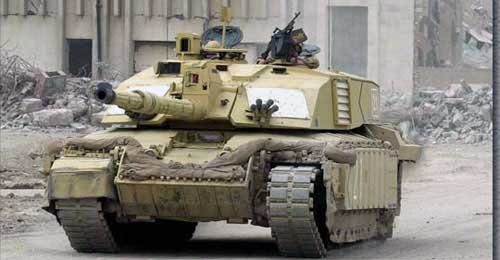 Thus, before the British had to choose not only and not so much the technical and tactical. how many political and economic. The result of that choice was of course the same predetermined. And "Abrams" and "Leopard" in 1987 passed comparative tests in Bovington (the English side to have participated "Challenger"), but as a result of the analysis of the western military-technical press 1987-1991. the impression that the Americans and the Germans did not attach much importance to English competition.
Thus, before the British had to choose not only and not so much the technical and tactical. how many political and economic. The result of that choice was of course the same predetermined. And "Abrams" and "Leopard" in 1987 passed comparative tests in Bovington (the English side to have participated "Challenger"), but as a result of the analysis of the western military-technical press 1987-1991. the impression that the Americans and the Germans did not attach much importance to English competition.
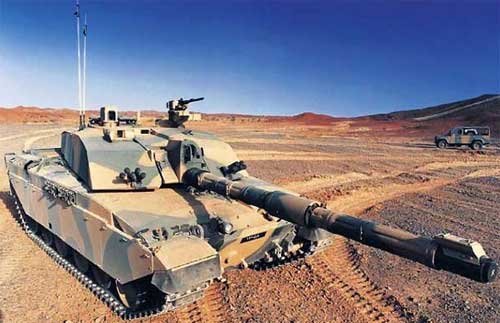 The favorite was the "Challenger-2" firm Vickers Difens Systems, despite the fact that, in 1987, it existed only on paper. The project was presented in March 1987. The main focus was on the development of new turrets, guns and weapons control systems, that is all that "nedomodernizirovali" on "Challenger" in comparison with "Chiftenom". In early 1988, Vickers company management decided to produce their own means of experienced eight towers, the first of which was ready in the autumn of the same year, and in December the Ministry of Defence signed a contract to manufacture and conduct demonstration tests of prototypes. Total was built nine experienced tanks "Challenger-2" and the two towers, "shot" on the ballistic tests.
The favorite was the "Challenger-2" firm Vickers Difens Systems, despite the fact that, in 1987, it existed only on paper. The project was presented in March 1987. The main focus was on the development of new turrets, guns and weapons control systems, that is all that "nedomodernizirovali" on "Challenger" in comparison with "Chiftenom". In early 1988, Vickers company management decided to produce their own means of experienced eight towers, the first of which was ready in the autumn of the same year, and in December the Ministry of Defence signed a contract to manufacture and conduct demonstration tests of prototypes. Total was built nine experienced tanks "Challenger-2" and the two towers, "shot" on the ballistic tests.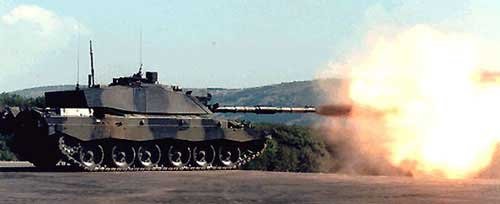 The tests of the first prototype began in 1989. The final selection of the winner of "competition" - tank "Challenger-2" - miraculously coincided with the end of 1991 its demonstration tests. "The highlight of the" tank "Challenger-2" became the new tower design. when her design firm Vickers specialists have used the experience gained in the development of Vickers tanks Mk.7 towers and Brazilian EE-T1 "Osorio" (Tower of the machine did the British). Tower - the new tank "Challenger 2" compared to the tower tank "Challenger" and other form has a smaller radar signature. With the advent of aircraft radar reconnaissance of ground targets class American "DZHISTARS" tank builders have been paying great attention to reduce the visibility. The new 120-mm rifled gun with a long barrel L30 55 caliber designed specifically for prospective tank gun L11 with his hometown only common ammunition (known to all NATO members to pull the unification of all things). Channel trunk in order to increase the life of tools made chrome; diameter pins and sockets for them increased to reduce the vibrations of the barrel in azimuth and elevation and, as a consequence,
The tests of the first prototype began in 1989. The final selection of the winner of "competition" - tank "Challenger-2" - miraculously coincided with the end of 1991 its demonstration tests. "The highlight of the" tank "Challenger-2" became the new tower design. when her design firm Vickers specialists have used the experience gained in the development of Vickers tanks Mk.7 towers and Brazilian EE-T1 "Osorio" (Tower of the machine did the British). Tower - the new tank "Challenger 2" compared to the tower tank "Challenger" and other form has a smaller radar signature. With the advent of aircraft radar reconnaissance of ground targets class American "DZHISTARS" tank builders have been paying great attention to reduce the visibility. The new 120-mm rifled gun with a long barrel L30 55 caliber designed specifically for prospective tank gun L11 with his hometown only common ammunition (known to all NATO members to pull the unification of all things). Channel trunk in order to increase the life of tools made chrome; diameter pins and sockets for them increased to reduce the vibrations of the barrel in azimuth and elevation and, as a consequence, 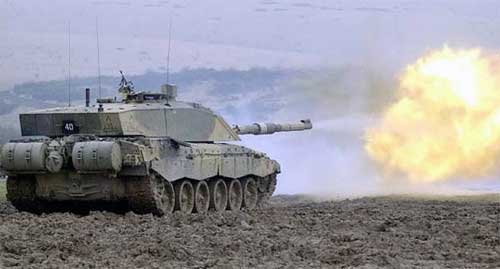 Ammunition for the gun includes 50 rounds of separate charging; shells and charges are stored in the new design of combat pack separately from each other. During the development of the tower involves the installation of charging machine, but for various reasons (the complexity of the design, reducing the reliability of the vulnerability in combat) had to abandon the idea. Gun angles pointing vertically from -10 ° to + 20 °. turn actuators of the tower and pointing guns - all-electric. The gun is stabilized in two planes. To the left of the guns mounted 7.62-mm machine gun "Chain Gang" paired with it, such as a machine gun mounted on the turret near the loader's hatch. Ammunition to the gun 4000 rounds. In front of the tower has a smoke grenade, five on each side.
Ammunition for the gun includes 50 rounds of separate charging; shells and charges are stored in the new design of combat pack separately from each other. During the development of the tower involves the installation of charging machine, but for various reasons (the complexity of the design, reducing the reliability of the vulnerability in combat) had to abandon the idea. Gun angles pointing vertically from -10 ° to + 20 °. turn actuators of the tower and pointing guns - all-electric. The gun is stabilized in two planes. To the left of the guns mounted 7.62-mm machine gun "Chain Gang" paired with it, such as a machine gun mounted on the turret near the loader's hatch. Ammunition to the gun 4000 rounds. In front of the tower has a smoke grenade, five on each side.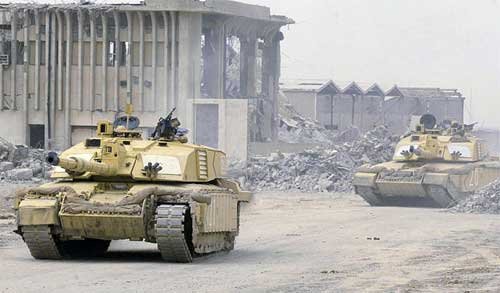 The jobs of the crew in the new tower are located as well as in the turret of a tank "Challenger": the right of the gunner guns, commanding him (commander somewhat elevated above the gunner's seat), the loader - on the left of the gun. Electronic instrumentation and new tower completely replaced. For the first time on British armored vehicle mounted bus Mil Std 1553 data - the standard interface of the NATO military equipment, including helicopter gunships. It is believed that the transition to a single standard interface and equipping them various combat weapons allow for the so-called "didzhitalizatsiyu" battlefield and dramatically increase the speed of information exchange between heterogeneous forces, leading the fighting. Combined stabilized gunner's sight developed by Barr End Stroud in cooperation with the French SAGEM.
The jobs of the crew in the new tower are located as well as in the turret of a tank "Challenger": the right of the gunner guns, commanding him (commander somewhat elevated above the gunner's seat), the loader - on the left of the gun. Electronic instrumentation and new tower completely replaced. For the first time on British armored vehicle mounted bus Mil Std 1553 data - the standard interface of the NATO military equipment, including helicopter gunships. It is believed that the transition to a single standard interface and equipping them various combat weapons allow for the so-called "didzhitalizatsiyu" battlefield and dramatically increase the speed of information exchange between heterogeneous forces, leading the fighting. Combined stabilized gunner's sight developed by Barr End Stroud in cooperation with the French SAGEM.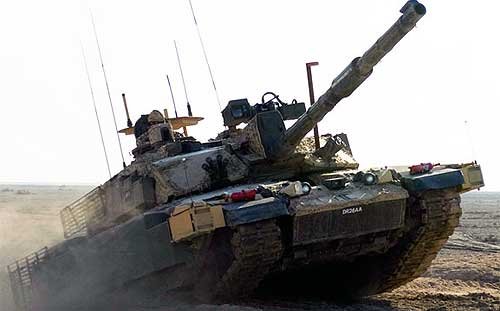 Daytime optical channel has a 4- or 10-fold increase, night - 4- or 11.4-fold; in sight integrated laser rangefinder. The head can be rotated sight + / -7 ° relative to the longitudinal axis of the tower. As a sensitive element of the night channel imager used TOGS-2, developed on the basis of thermal TOGS tank "Challenger". The sensing element is mounted on the gun barrel and covered with armored flap that opens only when the night channel. As a subsidiary used telescopic sight NANOQUEST L30. The commander installed stabilized panoramic periscope sight SFIM, which is a simplified sight of the French tank "Leclerc" (there is no night channel).
Daytime optical channel has a 4- or 10-fold increase, night - 4- or 11.4-fold; in sight integrated laser rangefinder. The head can be rotated sight + / -7 ° relative to the longitudinal axis of the tower. As a sensitive element of the night channel imager used TOGS-2, developed on the basis of thermal TOGS tank "Challenger". The sensing element is mounted on the gun barrel and covered with armored flap that opens only when the night channel. As a subsidiary used telescopic sight NANOQUEST L30. The commander installed stabilized panoramic periscope sight SFIM, which is a simplified sight of the French tank "Leclerc" (there is no night channel).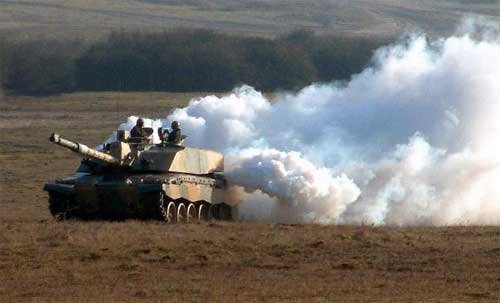 Optical channel has a 3- or 8-fold increase. In the field of sight displays information about the location of the tank and its course. To combat operations at night there is a video monitoring unit, which displays an image of the night channel gunner's sight. Along the perimeter of the commander's cupola with eight observational instruments, giving a total circular field of view. weapon control system is built around a digital computer CDC Canadian firm. which is a modernized computer tank M1A1 "Abrams". Using the JMA, the commander can direct their own gun and keep him out of the fire, to mark the selected target or fully pass gun control gunner, at the same time continuing to independent search of new goals. A typical cycle-aiming defeat takes just eight seconds. So, separate crews hit eight goals in 42 seconds during the test prototypes.
Optical channel has a 3- or 8-fold increase. In the field of sight displays information about the location of the tank and its course. To combat operations at night there is a video monitoring unit, which displays an image of the night channel gunner's sight. Along the perimeter of the commander's cupola with eight observational instruments, giving a total circular field of view. weapon control system is built around a digital computer CDC Canadian firm. which is a modernized computer tank M1A1 "Abrams". Using the JMA, the commander can direct their own gun and keep him out of the fire, to mark the selected target or fully pass gun control gunner, at the same time continuing to independent search of new goals. A typical cycle-aiming defeat takes just eight seconds. So, separate crews hit eight goals in 42 seconds during the test prototypes.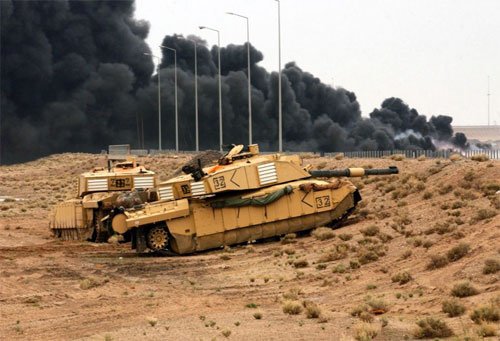 Housing tank "Challenger-2" compared to the previous tank corps 'Challenger' in appearance has not changed, but its filling has undergone deep modernization, although not as drastic as the tower. The case itself, as well as the tower and screens made of advanced armor "chobhem", having increased in comparison with the armor "Challenger" snaryadostoykost. In front of the housing units are available for mounting the dozer equipment. Constructors offered to equip the tank 1500-strong diesel engine option 12V, but the military considered it possible to leave the old - a 1200 strong. Transmission TN-54, installed on the "Challenger-2", has already been tested on ARV and "Challenger" latest releases. Total in the construction of motor-gear unit made 44 changes. For example, air filters are installed new design, improved alternator and starter motor, cooling system, transmission lubrication system, reinforced bolting unit. Designers "Challenger-2" made a nod to the Soviet tank builders.
Housing tank "Challenger-2" compared to the previous tank corps 'Challenger' in appearance has not changed, but its filling has undergone deep modernization, although not as drastic as the tower. The case itself, as well as the tower and screens made of advanced armor "chobhem", having increased in comparison with the armor "Challenger" snaryadostoykost. In front of the housing units are available for mounting the dozer equipment. Constructors offered to equip the tank 1500-strong diesel engine option 12V, but the military considered it possible to leave the old - a 1200 strong. Transmission TN-54, installed on the "Challenger-2", has already been tested on ARV and "Challenger" latest releases. Total in the construction of motor-gear unit made 44 changes. For example, air filters are installed new design, improved alternator and starter motor, cooling system, transmission lubrication system, reinforced bolting unit. Designers "Challenger-2" made a nod to the Soviet tank builders.
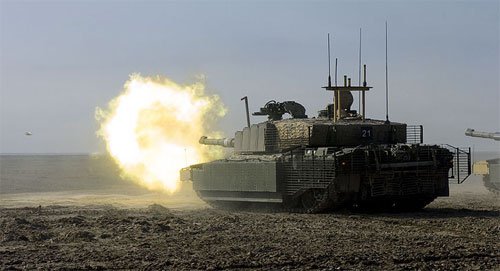 discharged two external fuel tanks (capacity of 204.5 liters each) for the first time installed on the western tank, so to criticize all sorts of experts on Soviet tanks. To create a smoke screen, in addition to traditional smoke grenades used diesel fuel injection device in the exhaust system - the solution has long been used on tanks designed in the Soviet Union. "Challenger-2" The first serial tank is manufactured at a factory in Leeds in July 1994. The British Army plans to buy 386 machines. In December 1995, the first tanks entered service Guards Royal Scots Dragoon Regiment. Operation of these armored vehicles identified a set of drawbacks, most of which was related to the sights and weapon control system. As the Ministry of Defence signed an agreement with the firm Vickers "fixed" contract, specifying in advance the gross price. It proposed to eliminate the shortcomings Vickers company at his own expense. For a long time these same shortcomings were only "fixed", so in November 1997, of the 150 built by this time in the army tanks were only 36 (all in the Scottish Dragoons) used for crew training. The rest were stored in two factories firm Vickers awaiting modernization. In 1995, 18 tanks, "Challenger-2" bought Oman's armed forces (signed contract for the supply in 1993).
discharged two external fuel tanks (capacity of 204.5 liters each) for the first time installed on the western tank, so to criticize all sorts of experts on Soviet tanks. To create a smoke screen, in addition to traditional smoke grenades used diesel fuel injection device in the exhaust system - the solution has long been used on tanks designed in the Soviet Union. "Challenger-2" The first serial tank is manufactured at a factory in Leeds in July 1994. The British Army plans to buy 386 machines. In December 1995, the first tanks entered service Guards Royal Scots Dragoon Regiment. Operation of these armored vehicles identified a set of drawbacks, most of which was related to the sights and weapon control system. As the Ministry of Defence signed an agreement with the firm Vickers "fixed" contract, specifying in advance the gross price. It proposed to eliminate the shortcomings Vickers company at his own expense. For a long time these same shortcomings were only "fixed", so in November 1997, of the 150 built by this time in the army tanks were only 36 (all in the Scottish Dragoons) used for crew training. The rest were stored in two factories firm Vickers awaiting modernization. In 1995, 18 tanks, "Challenger-2" bought Oman's armed forces (signed contract for the supply in 1993).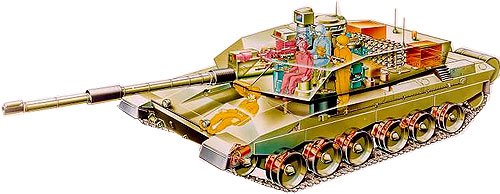 In 1997 he signed a contract for the supply of another 20 tanks for delivery in the first half of 2000. In tanks, "Challenger-2" intended to Oman, modified cooling system and air-conditioning system, the tower instead of a machine gun caliber 7.62 mm mounted 12.7mm M2 machine gun. "Desert" modification tank was created specifically to participate in the competition for the main battle tank for the Saudi Arabian armed forces. Competitor "Challenger-2" played American M1A2 "Abrams". Comparative tests were held in the summer of 1996, however, the Saudis chose "Abrams". The engine was replaced by the German diesel MT883Ka-500 power of 1500 hp, and the transmission TN-54 - German as transmission Renk HWSL-295TM.Byli modified cooling system and air filters, installed digital motor control system with night ustanovki.Pritsel commander channel is completely similar sight SFIM tank "Leclerc"
In 1997 he signed a contract for the supply of another 20 tanks for delivery in the first half of 2000. In tanks, "Challenger-2" intended to Oman, modified cooling system and air-conditioning system, the tower instead of a machine gun caliber 7.62 mm mounted 12.7mm M2 machine gun. "Desert" modification tank was created specifically to participate in the competition for the main battle tank for the Saudi Arabian armed forces. Competitor "Challenger-2" played American M1A2 "Abrams". Comparative tests were held in the summer of 1996, however, the Saudis chose "Abrams". The engine was replaced by the German diesel MT883Ka-500 power of 1500 hp, and the transmission TN-54 - German as transmission Renk HWSL-295TM.Byli modified cooling system and air filters, installed digital motor control system with night ustanovki.Pritsel commander channel is completely similar sight SFIM tank "Leclerc"